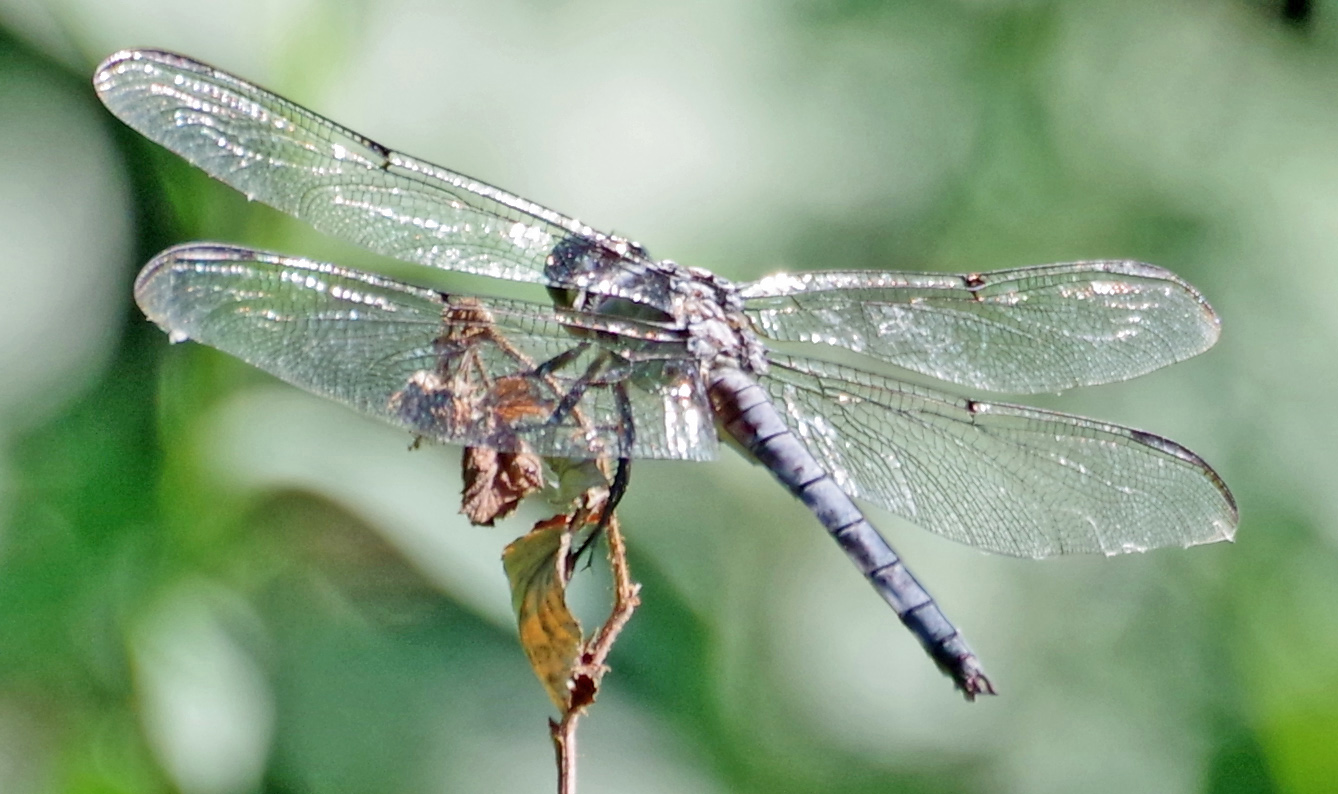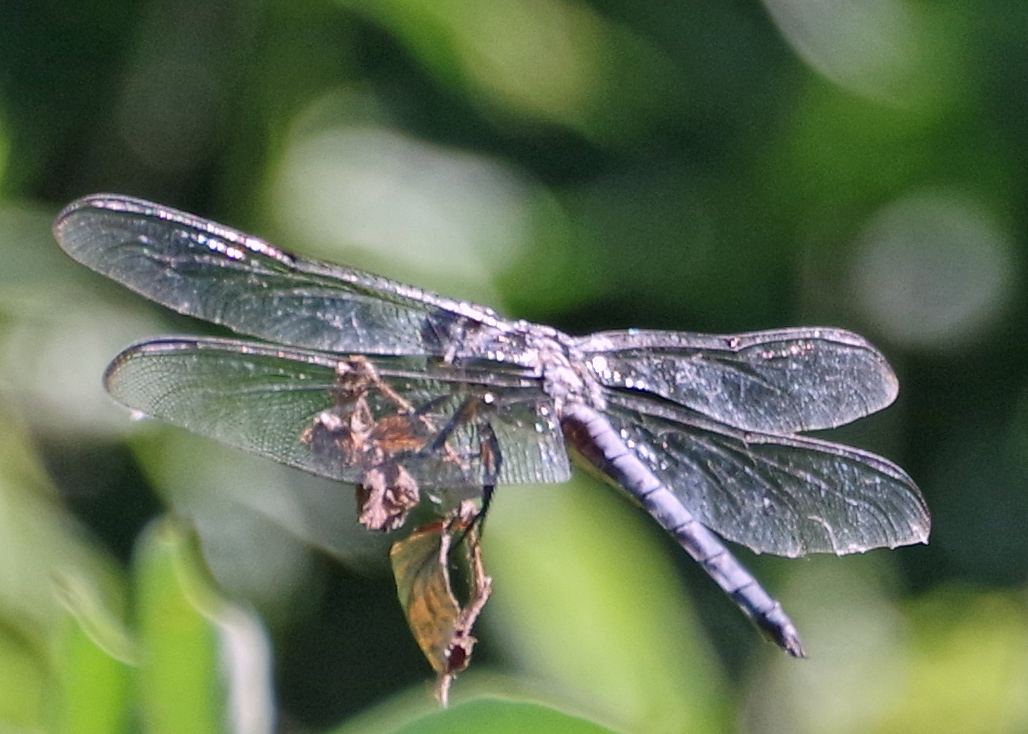
Great Blue Skimmer Dragonfly
Howdy, BugFans,
The BugLady was looking for bugs in Kohler-Andrae State Park in late July when a large dragonfly flew across the trail and landed about 12 feet up on some shrubs. She took a picture from about 25 feet away, looked at the camera’s screen, and got pretty excited. The dragonfly’s abdomen was dark blue, but it was larger than the blue-bodied, black-eyed Slaty Skimmers that she’s familiar with https://bugguide.net/node/view/2018015/bgimage. She stalked it and got two pictures of it before it departed – one was bad, and the other was worse, and that’s the way it goes sometimes.
She massaged the pictures so that the operative field marks – eye color, markings on the wings, and color of the stigma (the pigmented spot toward the outer margin of the wing) – were “visible,” and then she sent them off to some people who are smarter than she is. The verdict? It was a Great Blue Skimmer, a dragonfly that’s rare in Wisconsin (thanks, Dan and BugFan Freda). According to the wonderful, searchable Wisconsin Odonata Survey website https://wiatri.net/inventory/odonata/, Great Blue Skimmers have been recorded in only five of the past 15 years, and most of those years saw only one or two individuals. This year has been exceptional – there have been almost a dozen reports, some of several males in the same location.
Great Blue Skimmers are common across the Southeast, but they wander north, sometimes as far north as Massachusetts, and rarely, Maine and Ontario. One source referred to them as migrants, but that implies a return trip (only about 15 of the 331 North American dragonfly species are migratory (and a few of the damselflies roam a bit) – here’s the Xerces Society’s Guide https://www.xerces.org/sites/default/files/2018-05/12-036_01_MDP_Field_Guide_4-4-2013Websec.pdf). In Dragonflies and Damselflies of the East, Dennis Paulson speculates that climate change may be allowing these skimmers to extend their range northwards, but he also wonders whether wet periods in the East may drive their episodic range expansions.
Great Blue Skimmers (Libellula vibrans) are in the Skimmer family Libellulidae. Members of the genus Libellula are called the King Skimmers – large, often flashy, aggressive dragonflies that dominate the sunny ponds where they live. At almost 2.5” long, Great Blue Skimmers are the largest of the skimmers. Their “plumage” changes depending on age and sex – young females https://bugguide.net/node/view/182934/bgimage and young males have yellow abdomens with a black stripe https://bugguide.net/node/view/1936981/bgimage. Older females turn a dull brown with blue-ish to reddish-brown eyes https://bugguide.net/node/view/700746/bgimage, and mature males are a spectacular blue, with teal-colored eyes https://bugguide.net/node/view/787748/bgimage. Like many dragonflies, the intensity of the adult colors is softened somewhat as it ages by tiny wax particles called pruinescence, which produce a hoary appearance. They have white faces and pale, unstriped thoraxes https://bugguide.net/node/view/110122/bgimage, and the amount of black wrapping the tips of the wings is variable.

Don’t look for them over sunny ponds with the other King Skimmers – these are dragonflies of the dappled sunlight of woodlands, edges, and roads through wetlands and bottomlands, where they may be the only dragonflies around. They perch on twigs (at eye level and easy to photograph, said one source; at five to ten feet above the ground, said another).
Males vigorously defend stretches of ponds that look like good spots for a female to oviposit – Great Blue Skimmers prefer shallow, wooded pools and ponds, swamps, ditches, and very slow-moving sections of streams (and there are reports of females ovipositing in muddy tire tracks). Paulson says that they like “dark, mucky water.” They mate (very briefly) https://bugguide.net/node/view/1664022/bgimage, and then he releases her, but he guards her from the air (“hover guarding”) and shoos away rival males as she lays eggs.
She has a unique approach to ovipositing – she flies down to the water’s surface with eggs at the ready (scroll way down for a picture of eggs https://www.marylandbiodiversity.com/view/740), then she dips down and uses her abdomen to scoop and splash a bit of water, plus eggs, up to six inches away (“She may splash eggs and water onto the bank, presumably for a rainy day,” says Legler, in Dragonflies of Wisconsin). Watch the video to see her technique https://waltersanford.wordpress.com/2012/07/16/great-blue-skimmer-dragonflies-mating-pair-fe/. The drops of water are thought to help the eggs adhere to land. When the eggs hatch, the tiny naiads crawl into the water.
As always, both the aerial adults and the aquatic naiads are carnivorous – the adults spot their insect prey from perches in the shade and fly out to grab it, a behavior called “hawking,” and their menu includes smaller dragonflies.
The BugLady doesn’t care how common this dragonfly is within its range, it distresses her to find ads offering pinned specimens for “$40 to $60 depending on quality and sex” (which also sounds caveat emptor-ish to her).
The BugLady attempts a lot of Hail Mary Shots of dragonflies in flight (in fact, a recent shot of distant Common Green Darners flying in tandem seems to have an equally-distant Great Blue Skimmer in it), but most of them end up on the cutting room floor. She’d like to give a shout-out to this one https://bugguide.net/node/view/231364/bgimage.
Kate Redmond, The BugLady
And speaking of rare Lepidopterans – heads-up in the Pacific Northwest: https://www.smithsonianmag.com/smart-news/first-us-sighting-of-massive-atlas-moth-confirmed-180980617/?utm_source=smithsoniandaily&utm_medium=email&utm_campaign=20220822-daily-responsive&spMailingID=47269440&spUserID=ODg4Mzc3MzY0MTUyS0&spJobID=2302313711&spReportId=MjMwMjMxMzcxMQS2
Bug of the Week archives:
http://uwm.edu/field-station/category/bug-of-the-week/
